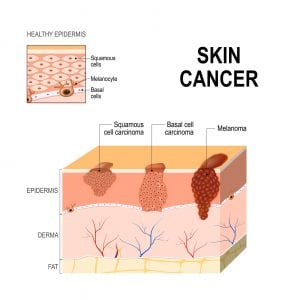Sun Damage and Squamous Cell Carcinoma
- office-locations
- our-doctors
- skin-conditions

Sun damage is one of the most prevalent causes of skin cancer, and squamous cell carcinoma is no exception. It is very important to practice sun protection at every opportunity to avoid exposure to dangerous UV rays that can cause lasting damage to your skin.
What is squamous cell carcinoma?
Squamous cell carcinoma is the second most common form of skin cancer, that’s usually found on areas of the body that have been damaged by sun exposure or tanning beds. These areas usually include the head, neck, chest, upper back, ears, lips, arms, legs and hands.
What are the other causes of squamous cell carcinoma?
If you are an older, fair-skinned male with blue, green or gray eyes and blonde or red hair, you could be more likely to develop squamous cell carcinoma due to genetic factors. Of course, sun damage is also a major cause and can happen because of too much time spent in tanning beds or outside, exposed to dangerous UV rays without the protection of sunscreen. Squamous cell carcinoma can also be caused by long-term exposure to dangers like arsenic or radiation, or if you have Bowen’s disease, HPV, HIV or AIDS.

What are the symptoms?
Like some other forms of skin cancer, squamous cell carcinoma usually pops up on the skin as a bump or red, scaly patch that bleeds when scraped. That’s why it’s important to take part in regular skin cancer screenings with Charleston Dermatology and perform consistent self-checks to make sure that any irregularities are caught in time.
What can I expect from an exam with Charleston Dermatology?
First, we will inquire about your medical history, your experience with the sun and/or tanning beds and your current symptoms. If you’ve noticed an irregularity during a self-check, we’ll perform a prolonged investigation into the spot in question. We may remove a sample and send to the lab for testing. This procedure is called a skin biopsy. Otherwise, we’ll perform a physical exam that checks the entire body.
How do you treat the cancerous spot?
Treatment depends on the size of the cancer, the stage of the cancer and its location on the body. The majority of cancers are treated surgically and some require a surgical technique called Mohs micrographic surgery. Some small cancers may be treated with topical or injectable chemotherapy. Should your cancer require surgery, our physicians have expertise in reconstruction of the tissue removed to minimize scarring and achieve an excellent aesthetic outcome.
Once you’ve been diagnosed with squamous cell carcinoma, you’re more likely to get it again, so it’s imperative to perform regular self-checks and come in for physical exams. Because squamous cell carcinoma grows more slowly than some other forms of skin cancer, if it’s caught early, it’s easy to treat. However, if it goes unchecked, it can spread to the tissues, bones and lymph nodes, which is much more difficult to treat.
Source: https://www.webmd.com/melanoma-skin-cancer/guide/squamous-cell-carcinoma#1
